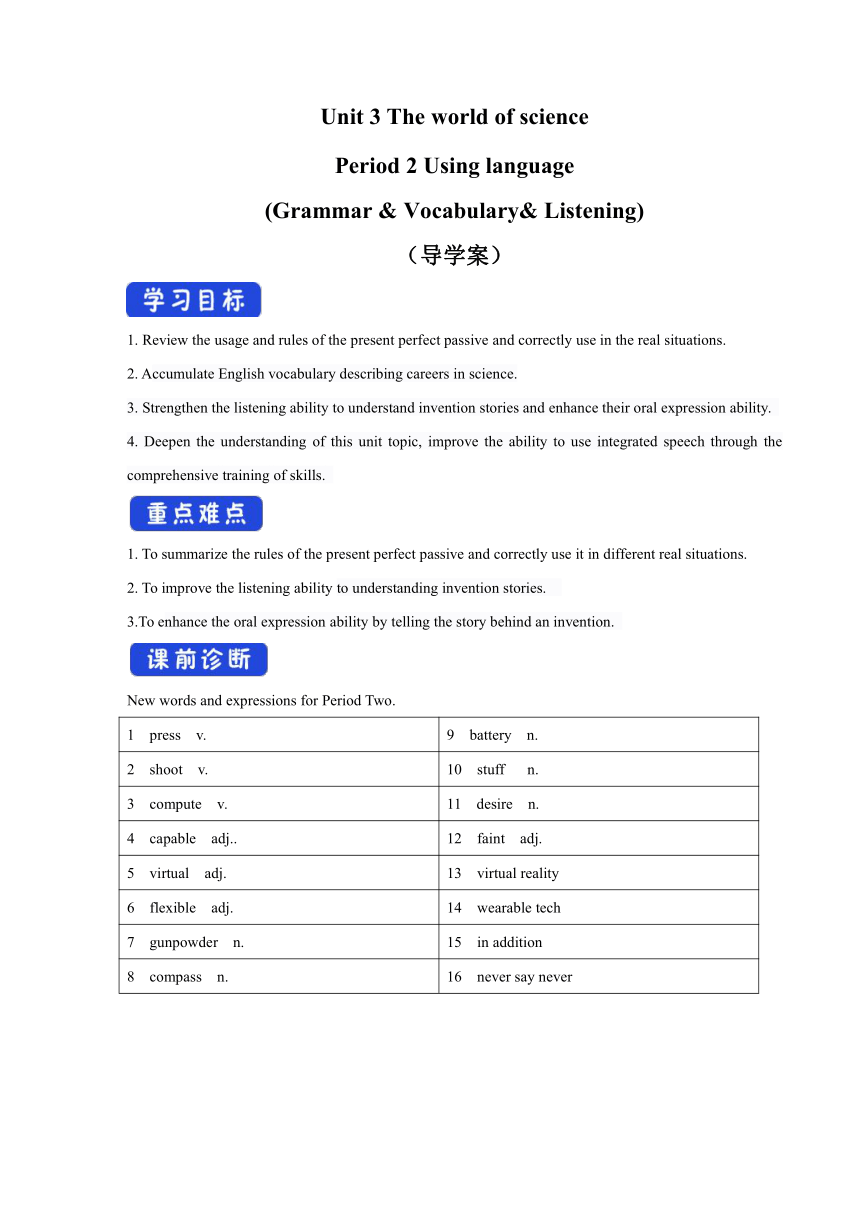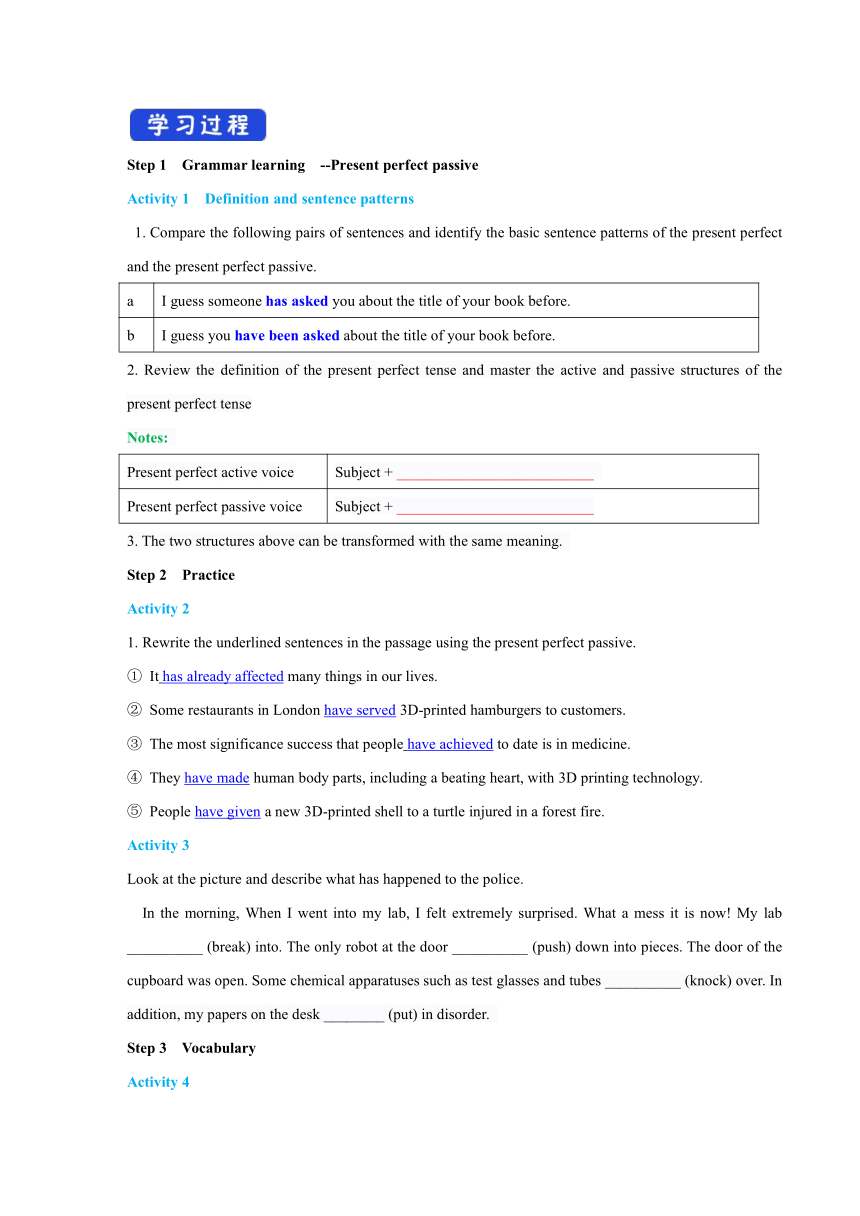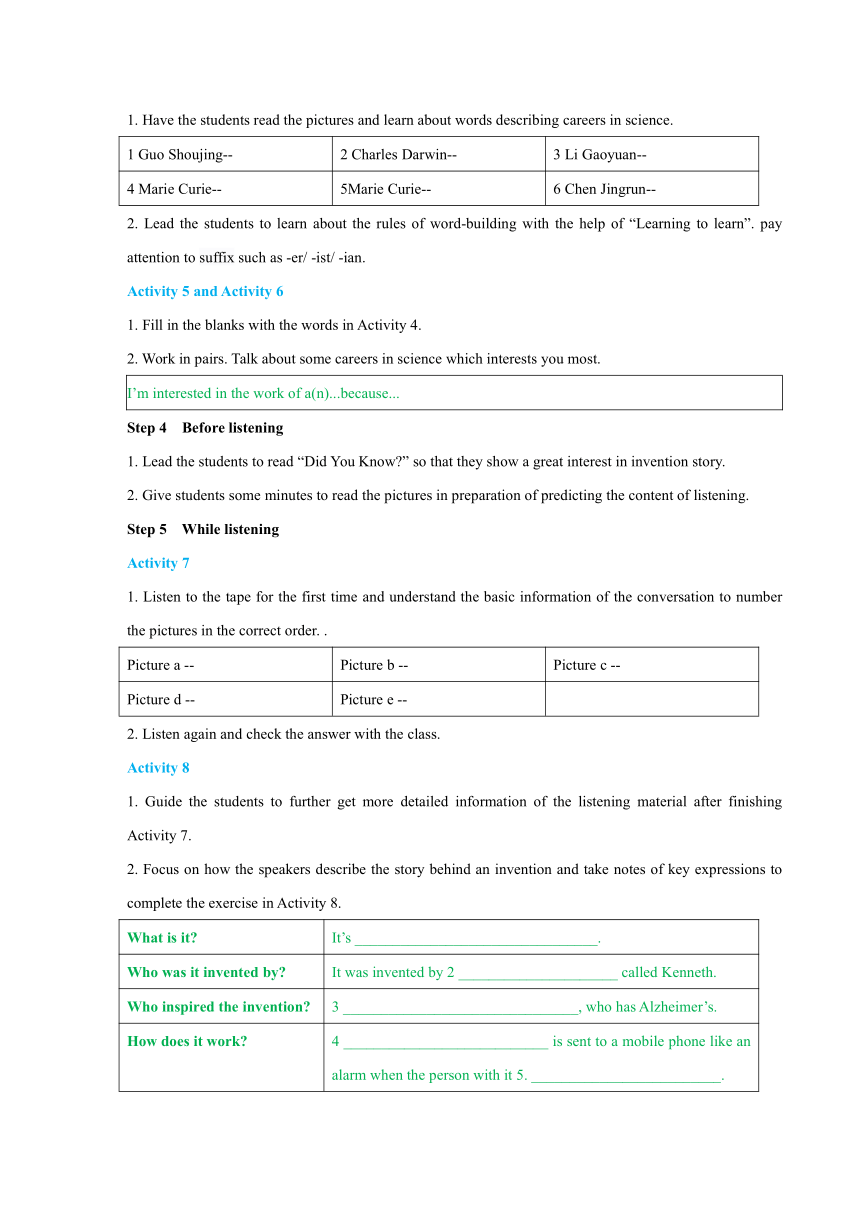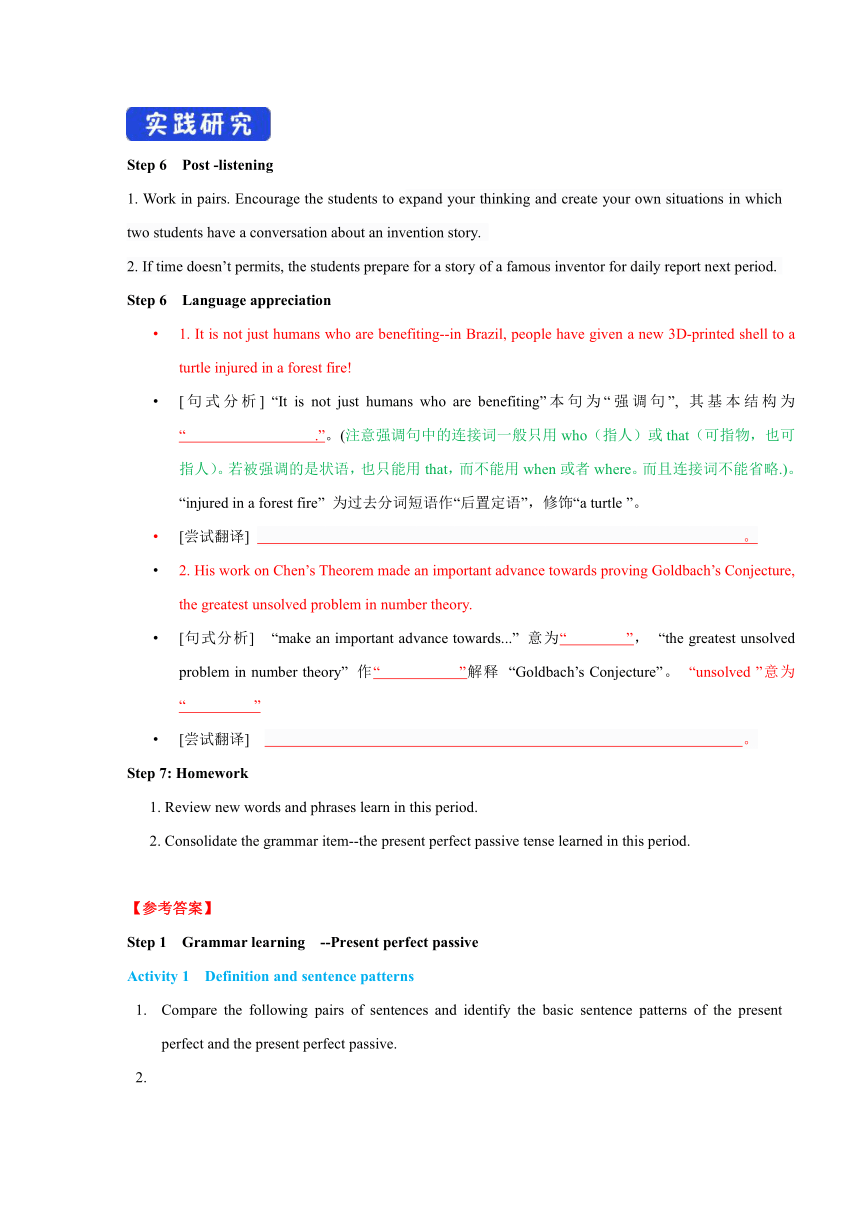外研版(2019) 必修第三册 Unit 3 The world of scienceUsing languages 导学案(1)
文档属性
| 名称 | 外研版(2019) 必修第三册 Unit 3 The world of scienceUsing languages 导学案(1) |

|
|
| 格式 | zip | ||
| 文件大小 | 64.1KB | ||
| 资源类型 | 教案 | ||
| 版本资源 | 外研版(2019) | ||
| 科目 | 英语 | ||
| 更新时间 | 2022-08-23 10:07:31 | ||
图片预览




文档简介
Unit 3 The world of science
Period 2 Using language
(Grammar & Vocabulary& Listening)
(导学案)
1. Review the usage and rules of the present perfect passive and correctly use in the real situations.
2. Accumulate English vocabulary describing careers in science.
3. Strengthen the listening ability to understand invention stories and enhance their oral expression ability.
4. Deepen the understanding of this unit topic, improve the ability to use integrated speech through the comprehensive training of skills.
1. To summarize the rules of the present perfect passive and correctly use it in different real situations.
2. To improve the listening ability to understanding invention stories.
3.To enhance the oral expression ability by telling the story behind an invention.
New words and expressions for Period Two.
1 press v. 9 battery n.
2 shoot v. 10 stuff n.
3 compute v. 11 desire n.
4 capable adj.. 12 faint adj.
5 virtual adj. 13 virtual reality
6 flexible adj. 14 wearable tech
7 gunpowder n. 15 in addition
8 compass n. 16 never say never
Step 1 Grammar learning --Present perfect passive
Activity 1 Definition and sentence patterns
1. Compare the following pairs of sentences and identify the basic sentence patterns of the present perfect and the present perfect passive.
a I guess someone has asked you about the title of your book before.
b I guess you have been asked about the title of your book before.
2. Review the definition of the present perfect tense and master the active and passive structures of the present perfect tense
Notes:
Present perfect active voice Subject + __________________________
Present perfect passive voice Subject + __________________________
3. The two structures above can be transformed with the same meaning.
Step 2 Practice
Activity 2
1. Rewrite the underlined sentences in the passage using the present perfect passive.
① It has already affected many things in our lives.
② Some restaurants in London have served 3D-printed hamburgers to customers.
③ The most significance success that people have achieved to date is in medicine.
④ They have made human body parts, including a beating heart, with 3D printing technology.
⑤ People have given a new 3D-printed shell to a turtle injured in a forest fire.
Activity 3
Look at the picture and describe what has happened to the police.
In the morning, When I went into my lab, I felt extremely surprised. What a mess it is now! My lab __________ (break) into. The only robot at the door __________ (push) down into pieces. The door of the cupboard was open. Some chemical apparatuses such as test glasses and tubes __________ (knock) over. In addition, my papers on the desk ________ (put) in disorder.
Step 3 Vocabulary
Activity 4
1. Have the students read the pictures and learn about words describing careers in science.
1 Guo Shoujing-- 2 Charles Darwin-- 3 Li Gaoyuan--
4 Marie Curie-- 5Marie Curie-- 6 Chen Jingrun--
2. Lead the students to learn about the rules of word-building with the help of “Learning to learn”. pay attention to suffix such as -er/ -ist/ -ian.
Activity 5 and Activity 6
1. Fill in the blanks with the words in Activity 4.
2. Work in pairs. Talk about some careers in science which interests you most.
I’m interested in the work of a(n)...because...
Step 4 Before listening
1. Lead the students to read “Did You Know ” so that they show a great interest in invention story.
2. Give students some minutes to read the pictures in preparation of predicting the content of listening.
Step 5 While listening
Activity 7
1. Listen to the tape for the first time and understand the basic information of the conversation to number the pictures in the correct order. .
Picture a -- Picture b -- Picture c --
Picture d -- Picture e --
2. Listen again and check the answer with the class.
Activity 8
1. Guide the students to further get more detailed information of the listening material after finishing Activity 7.
2. Focus on how the speakers describe the story behind an invention and take notes of key expressions to complete the exercise in Activity 8.
What is it It’s ________________________________.
Who was it invented by It was invented by 2 _____________________ called Kenneth.
Who inspired the invention 3 _______________________________, who has Alzheimer’s.
How does it work 4 ___________________________ is sent to a mobile phone like an alarm when the person with it 5. _________________________.
Step 6 Post -listening
1. Work in pairs. Encourage the students to expand your thinking and create your own situations in which two students have a conversation about an invention story.
2. If time doesn’t permits, the students prepare for a story of a famous inventor for daily report next period.
Step 6 Language appreciation
1. It is not just humans who are benefiting--in Brazil, people have given a new 3D-printed shell to a turtle injured in a forest fire!
[句式分析] “It is not just humans who are benefiting”本句为“强调句”, 其基本结构为“ .”。(注意强调句中的连接词一般只用who(指人)或that(可指物,也可指人)。若被强调的是状语,也只能用that,而不能用when或者where。而且连接词不能省略.)。 “injured in a forest fire” 为过去分词短语作“后置定语”,修饰“a turtle ”。
[尝试翻译] 。
2. His work on Chen’s Theorem made an important advance towards proving Goldbach’s Conjecture, the greatest unsolved problem in number theory.
[句式分析] “make an important advance towards...” 意为“ ”, “the greatest unsolved problem in number theory” 作“ ”解释 “Goldbach’s Conjecture”。 “unsolved ”意为“ ”
[尝试翻译] 。
Step 7: Homework
1. Review new words and phrases learn in this period.
2. Consolidate the grammar item--the present perfect passive tense learned in this period.
【参考答案】
Step 1 Grammar learning --Present perfect passive
Activity 1 Definition and sentence patterns
Compare the following pairs of sentences and identify the basic sentence patterns of the present perfect and the present perfect passive.
a I guess someone has asked you about the title of your book before.
b I guess you have been asked about the title of your book before.
2. Review the definition of the present perfect tense and master the active and passive structures of the present perfect tense.
Notes: 【答案】
Present perfect active voice Subject + have/has done+...
Present perfect passive voice Subject +have/has been done+...
3. The two structures above can be transformed with the same meaning.
Step 2 Practice
Activity 2
1. Rewrite the underlined sentences in the passage using the present perfect passive.
① It has already affected many things in our lives.
② Some restaurants in London have served 3D-printed hamburgers to customers.
③ The most significance success that people have achieved to date is in medicine.
④ They have made human body parts, including a beating heart, with 3D printing technology.
⑤ People have given a new 3D-printed shell to a turtle injured in a forest fire.
【答案】
① Many things in our lives have already been affected by it.
② 3D-printed hamburgers have been served to customers in some restaurants of London.
③ The most significance success that has been achieved to date is medicine.
④ Human body parts, including a beating heart, have been made by them, with 3D printing technology.
⑤ A new 3D-printed shell has been given to a turtle injured in a forest fire.
Activity 3
Look at the picture and describe what has happened to the police.
In the morning, When I went into my lab, I felt extremely surprised. What a mess it is now! My lab __________ (break) into. The only robot at the door __________ (push) down into pieces. The door of the cupboard was open. Some chemical apparatuses such as test glasses and tubes __________ (knock) over. In addition, my papers on the desk _________ (put) in disorder.
【答案】
In the morning, When I went into my lab, I felt extremely surprised. What a mess it is now! My lab has been broken (break) into. The only robot at the door has been pushed (push) down into pieces. The door of the cupboard was open. Some chemical apparatuses such as test glasses and tubes have been knocked (knock) over. In addition, my papers on the desk have been put (put) in disorder.
Step 3 Vocabulary
Activity 4
1. Have the students read the pictures and learn about words describing careers in science.
1 Guo Shoujing-- 2 Charles Darwin-- 3 Li Gaoyuan--
4 Marie Curie-- 5Marie Curie-- 6 Chen Jingrun--
【答案】
1 astronomer 2 biologist 3 geographer
4 physicist 5 chemist 6 mathematician
2. Lead the students to learn about the rules of word-building with the help of “Learning to learn”. pay attention to suffix such as -er/ -ist/ -ian.
Activity 5 and Activity 6
1. Fill in the blanks with the words in Activity 4.
2. Work in pairs. Talk about some careers in science which interests you most.
I’m interested in the work of a(n)...because...
【答案】(a possible answer:)
I’m interested in the work of a doctor because the doctor is a great occupation. The doctors who are called “Angels in white” are always working for patient’s health. They can help patients cure, when we are ill, such as colds, headaches, stomachaches and so on. The doctor also can save the patient's life. I will look at some of the medical aspects of the book to prepare for the future.
Step 4 Before listening
1. Lead the students to read “Did You Know ” so that they show a great interest in invention story.
2. Give students some minutes to read the pictures in preparation of predicting the content of listening.
Step 5 While listening
Activity 7
1. Listen to the tape for the first time and understand the basic information of the conversation to number the pictures in the correct order. .
Picture a -- Picture b -- Picture c --
Picture d -- Picture e --
【答案】(待定)
Picture a -- Picture b -- Picture c --
Picture d -- Picture e --
2. Listen again and check the answer with the class.
Activity 8
1. Guide the students to further get more detailed information of the listening material after finishing Activity 7.
2. Focus on how the speakers describe the story behind an invention and take notes of key expressions to complete the exercise in Activity 8.
What is it It’s 1________________________________.
Who was it invented by It was invented by 2 _____________________ called Kenneth.
Who inspired the invention 3 _______________________________, who has Alzheimer’s.
How does it work 4 ___________________________ is sent to a mobile phone like an alarm when the person with it 5. _________________________.
【答案】(待定)
What is it It’s 1________________________________.
Who was it invented by It was invented by 2 _____________________ called Kenneth.
Who inspired the invention 3 _______________________________, who has Alzheimer’s.
How does it work 4 ___________________________ is sent to a mobile phone like an alarm when the person with it 5 _________________________.
Step 6 Post -listening
1. Work in pairs. Encourage the students to expand your thinking and create your own situations in which two students have a conversation about an invention story.
2. If time doesn’t permits, the students prepare for a story of a famous inventor for daily report next period.
Step 6 Language appreciation
1. It is not just humans who are benefiting--in Brazil, people have given a new 3D-printed shell to a turtle injured in a forest fire!
[句式分析] “It is not just humans who are benefiting”本句为“强调句”, 其基本结构为“It’s + 被强调部分+ that+ ...”。(注意强调句中的连接词一般只用who(指人)或that(可指物,也可指人)。若被强调的是状语,也只能用that,而不能用when或者where。而且连接词不能省略.)。 “injured in a forest fire” 为过去分词短语作“后置定语”,修饰“a turtle ”。
[尝试翻译] 受益的不只是人类——在巴西,人们给一只在森林火灾中受伤的海龟一个新的3d打印外壳!
2. His work on Chen’s Theorem made an important advance towards proving Goldbach’s Conjecture, the greatest unsolved problem in number theory.
[句式分析] “make an important advance towards...” 意为“取得重要进展”, “the greatest unsolved problem in number theory” 作“同位语”解释 “Goldbach’s Conjecture”。 “unsolved ”意为“未解决的”
[尝试翻译] 陈氏(陈景润)定理的研究在证明哥德巴赫猜想方面取得了重要进展,哥德巴赫猜想是数论中最重要的未解问题。
Step 7: Homework
1. Review new words and phrases learn in this period.
2. Consolidate the grammar item learned in this period.
Period 2 Using language
(Grammar & Vocabulary& Listening)
(导学案)
1. Review the usage and rules of the present perfect passive and correctly use in the real situations.
2. Accumulate English vocabulary describing careers in science.
3. Strengthen the listening ability to understand invention stories and enhance their oral expression ability.
4. Deepen the understanding of this unit topic, improve the ability to use integrated speech through the comprehensive training of skills.
1. To summarize the rules of the present perfect passive and correctly use it in different real situations.
2. To improve the listening ability to understanding invention stories.
3.To enhance the oral expression ability by telling the story behind an invention.
New words and expressions for Period Two.
1 press v. 9 battery n.
2 shoot v. 10 stuff n.
3 compute v. 11 desire n.
4 capable adj.. 12 faint adj.
5 virtual adj. 13 virtual reality
6 flexible adj. 14 wearable tech
7 gunpowder n. 15 in addition
8 compass n. 16 never say never
Step 1 Grammar learning --Present perfect passive
Activity 1 Definition and sentence patterns
1. Compare the following pairs of sentences and identify the basic sentence patterns of the present perfect and the present perfect passive.
a I guess someone has asked you about the title of your book before.
b I guess you have been asked about the title of your book before.
2. Review the definition of the present perfect tense and master the active and passive structures of the present perfect tense
Notes:
Present perfect active voice Subject + __________________________
Present perfect passive voice Subject + __________________________
3. The two structures above can be transformed with the same meaning.
Step 2 Practice
Activity 2
1. Rewrite the underlined sentences in the passage using the present perfect passive.
① It has already affected many things in our lives.
② Some restaurants in London have served 3D-printed hamburgers to customers.
③ The most significance success that people have achieved to date is in medicine.
④ They have made human body parts, including a beating heart, with 3D printing technology.
⑤ People have given a new 3D-printed shell to a turtle injured in a forest fire.
Activity 3
Look at the picture and describe what has happened to the police.
In the morning, When I went into my lab, I felt extremely surprised. What a mess it is now! My lab __________ (break) into. The only robot at the door __________ (push) down into pieces. The door of the cupboard was open. Some chemical apparatuses such as test glasses and tubes __________ (knock) over. In addition, my papers on the desk ________ (put) in disorder.
Step 3 Vocabulary
Activity 4
1. Have the students read the pictures and learn about words describing careers in science.
1 Guo Shoujing-- 2 Charles Darwin-- 3 Li Gaoyuan--
4 Marie Curie-- 5Marie Curie-- 6 Chen Jingrun--
2. Lead the students to learn about the rules of word-building with the help of “Learning to learn”. pay attention to suffix such as -er/ -ist/ -ian.
Activity 5 and Activity 6
1. Fill in the blanks with the words in Activity 4.
2. Work in pairs. Talk about some careers in science which interests you most.
I’m interested in the work of a(n)...because...
Step 4 Before listening
1. Lead the students to read “Did You Know ” so that they show a great interest in invention story.
2. Give students some minutes to read the pictures in preparation of predicting the content of listening.
Step 5 While listening
Activity 7
1. Listen to the tape for the first time and understand the basic information of the conversation to number the pictures in the correct order. .
Picture a -- Picture b -- Picture c --
Picture d -- Picture e --
2. Listen again and check the answer with the class.
Activity 8
1. Guide the students to further get more detailed information of the listening material after finishing Activity 7.
2. Focus on how the speakers describe the story behind an invention and take notes of key expressions to complete the exercise in Activity 8.
What is it It’s ________________________________.
Who was it invented by It was invented by 2 _____________________ called Kenneth.
Who inspired the invention 3 _______________________________, who has Alzheimer’s.
How does it work 4 ___________________________ is sent to a mobile phone like an alarm when the person with it 5. _________________________.
Step 6 Post -listening
1. Work in pairs. Encourage the students to expand your thinking and create your own situations in which two students have a conversation about an invention story.
2. If time doesn’t permits, the students prepare for a story of a famous inventor for daily report next period.
Step 6 Language appreciation
1. It is not just humans who are benefiting--in Brazil, people have given a new 3D-printed shell to a turtle injured in a forest fire!
[句式分析] “It is not just humans who are benefiting”本句为“强调句”, 其基本结构为“ .”。(注意强调句中的连接词一般只用who(指人)或that(可指物,也可指人)。若被强调的是状语,也只能用that,而不能用when或者where。而且连接词不能省略.)。 “injured in a forest fire” 为过去分词短语作“后置定语”,修饰“a turtle ”。
[尝试翻译] 。
2. His work on Chen’s Theorem made an important advance towards proving Goldbach’s Conjecture, the greatest unsolved problem in number theory.
[句式分析] “make an important advance towards...” 意为“ ”, “the greatest unsolved problem in number theory” 作“ ”解释 “Goldbach’s Conjecture”。 “unsolved ”意为“ ”
[尝试翻译] 。
Step 7: Homework
1. Review new words and phrases learn in this period.
2. Consolidate the grammar item--the present perfect passive tense learned in this period.
【参考答案】
Step 1 Grammar learning --Present perfect passive
Activity 1 Definition and sentence patterns
Compare the following pairs of sentences and identify the basic sentence patterns of the present perfect and the present perfect passive.
a I guess someone has asked you about the title of your book before.
b I guess you have been asked about the title of your book before.
2. Review the definition of the present perfect tense and master the active and passive structures of the present perfect tense.
Notes: 【答案】
Present perfect active voice Subject + have/has done+...
Present perfect passive voice Subject +have/has been done+...
3. The two structures above can be transformed with the same meaning.
Step 2 Practice
Activity 2
1. Rewrite the underlined sentences in the passage using the present perfect passive.
① It has already affected many things in our lives.
② Some restaurants in London have served 3D-printed hamburgers to customers.
③ The most significance success that people have achieved to date is in medicine.
④ They have made human body parts, including a beating heart, with 3D printing technology.
⑤ People have given a new 3D-printed shell to a turtle injured in a forest fire.
【答案】
① Many things in our lives have already been affected by it.
② 3D-printed hamburgers have been served to customers in some restaurants of London.
③ The most significance success that has been achieved to date is medicine.
④ Human body parts, including a beating heart, have been made by them, with 3D printing technology.
⑤ A new 3D-printed shell has been given to a turtle injured in a forest fire.
Activity 3
Look at the picture and describe what has happened to the police.
In the morning, When I went into my lab, I felt extremely surprised. What a mess it is now! My lab __________ (break) into. The only robot at the door __________ (push) down into pieces. The door of the cupboard was open. Some chemical apparatuses such as test glasses and tubes __________ (knock) over. In addition, my papers on the desk _________ (put) in disorder.
【答案】
In the morning, When I went into my lab, I felt extremely surprised. What a mess it is now! My lab has been broken (break) into. The only robot at the door has been pushed (push) down into pieces. The door of the cupboard was open. Some chemical apparatuses such as test glasses and tubes have been knocked (knock) over. In addition, my papers on the desk have been put (put) in disorder.
Step 3 Vocabulary
Activity 4
1. Have the students read the pictures and learn about words describing careers in science.
1 Guo Shoujing-- 2 Charles Darwin-- 3 Li Gaoyuan--
4 Marie Curie-- 5Marie Curie-- 6 Chen Jingrun--
【答案】
1 astronomer 2 biologist 3 geographer
4 physicist 5 chemist 6 mathematician
2. Lead the students to learn about the rules of word-building with the help of “Learning to learn”. pay attention to suffix such as -er/ -ist/ -ian.
Activity 5 and Activity 6
1. Fill in the blanks with the words in Activity 4.
2. Work in pairs. Talk about some careers in science which interests you most.
I’m interested in the work of a(n)...because...
【答案】(a possible answer:)
I’m interested in the work of a doctor because the doctor is a great occupation. The doctors who are called “Angels in white” are always working for patient’s health. They can help patients cure, when we are ill, such as colds, headaches, stomachaches and so on. The doctor also can save the patient's life. I will look at some of the medical aspects of the book to prepare for the future.
Step 4 Before listening
1. Lead the students to read “Did You Know ” so that they show a great interest in invention story.
2. Give students some minutes to read the pictures in preparation of predicting the content of listening.
Step 5 While listening
Activity 7
1. Listen to the tape for the first time and understand the basic information of the conversation to number the pictures in the correct order. .
Picture a -- Picture b -- Picture c --
Picture d -- Picture e --
【答案】(待定)
Picture a -- Picture b -- Picture c --
Picture d -- Picture e --
2. Listen again and check the answer with the class.
Activity 8
1. Guide the students to further get more detailed information of the listening material after finishing Activity 7.
2. Focus on how the speakers describe the story behind an invention and take notes of key expressions to complete the exercise in Activity 8.
What is it It’s 1________________________________.
Who was it invented by It was invented by 2 _____________________ called Kenneth.
Who inspired the invention 3 _______________________________, who has Alzheimer’s.
How does it work 4 ___________________________ is sent to a mobile phone like an alarm when the person with it 5. _________________________.
【答案】(待定)
What is it It’s 1________________________________.
Who was it invented by It was invented by 2 _____________________ called Kenneth.
Who inspired the invention 3 _______________________________, who has Alzheimer’s.
How does it work 4 ___________________________ is sent to a mobile phone like an alarm when the person with it 5 _________________________.
Step 6 Post -listening
1. Work in pairs. Encourage the students to expand your thinking and create your own situations in which two students have a conversation about an invention story.
2. If time doesn’t permits, the students prepare for a story of a famous inventor for daily report next period.
Step 6 Language appreciation
1. It is not just humans who are benefiting--in Brazil, people have given a new 3D-printed shell to a turtle injured in a forest fire!
[句式分析] “It is not just humans who are benefiting”本句为“强调句”, 其基本结构为“It’s + 被强调部分+ that+ ...”。(注意强调句中的连接词一般只用who(指人)或that(可指物,也可指人)。若被强调的是状语,也只能用that,而不能用when或者where。而且连接词不能省略.)。 “injured in a forest fire” 为过去分词短语作“后置定语”,修饰“a turtle ”。
[尝试翻译] 受益的不只是人类——在巴西,人们给一只在森林火灾中受伤的海龟一个新的3d打印外壳!
2. His work on Chen’s Theorem made an important advance towards proving Goldbach’s Conjecture, the greatest unsolved problem in number theory.
[句式分析] “make an important advance towards...” 意为“取得重要进展”, “the greatest unsolved problem in number theory” 作“同位语”解释 “Goldbach’s Conjecture”。 “unsolved ”意为“未解决的”
[尝试翻译] 陈氏(陈景润)定理的研究在证明哥德巴赫猜想方面取得了重要进展,哥德巴赫猜想是数论中最重要的未解问题。
Step 7: Homework
1. Review new words and phrases learn in this period.
2. Consolidate the grammar item learned in this period.
